Partition based time series clustering in aeon#
Partition based clustering algorithms for time series are those where \(k\) clusters are created from \(n\) time series. The aim is to cluster so that each time series in a cluster are homogenous (similar) to each other and heterogeneous (dissimilar) to those outside the cluster.
Broadly speaking, clustering algorithms are either partitional or hierarchical. Partitional clustering algorithms assign (possibly probabilistic) cluster membership to each time series, usually through an iterative heuristic process of optimising some objective function that measures homogeneity. Given a dataset of \(n\) time series, \(D\), the partitional time series clustering problem is to partition \(D\) into \(k\) clusters, \(C = \{C_1, C_2, ..., C_k\}\) where \(k\) is the number of clusters.
To measure homogeneity and place a time series into a cluster, a metric or distance is used. For details of distances in aeon see the distances examples. The distance is used to compare a time series and assign cluster membership.
It is usually assumed that the number of clusters is set prior to the optimisation heuristic. If \(k\) is not set, it is commonly found through some wrapper method. We assume \(k\) is fixed in advance for all our experiments.
Currently, in aeon there are two types of time series partition algorithms implemented: \(k\)-means and \(k\)-medoids.
Imports#
[1]:
from sklearn.model_selection import train_test_split
from aeon.clustering.k_means import TimeSeriesKMeans
from aeon.clustering.k_medoids import TimeSeriesKMedoids
from aeon.clustering.utils.plotting._plot_partitions import plot_cluster_algorithm
from aeon.datasets import load_arrow_head
Load data#
[2]:
X, y = load_arrow_head(return_X_y=True)
X_train, X_test, y_train, y_test = train_test_split(X, y)
print(X_train.shape, y_train.shape, X_test.shape, y_test.shape)
(158, 1, 251) (158,) (53, 1, 251) (53,)
\(k\)-partition algorithms#
\(k\)-partition algorithms are those that seek to create \(k\) clusters and assign each time series to a cluster using a distance measure. In aeon the following are currently supported:
\(k\)-means - one of the most well known clustering algorithms. The goal of the \(k\)-means algorithm is to minimise a criterion known as the inertia or within-cluster sum-of-squares (uses the mean of the values in a cluster as the centre).
K-medoids - A similar algorithm to K-means but instead of using the mean of each cluster to determine the centre, the median series is used.
Algorithmically the common way to approach these k-partition algorithms is known as Lloyds algorithm. This is an iterative process that involves: - Initialisation - Assignment - Updating centroid - Repeat assigment and updating until convergence
Centre initialisation#
Centre initialisation is the first step and has been found to be critical in obtaining good results. There are three main centre initialisation that will now be outlined:
K-means, K-medoids supported centre initialisation:
Random - This is where each sample in the training dataset is randomly assigned to a cluster and update centres is run based on these random assignments i.e. for k-means the mean of these randomly assigned clusters is used and for k-medoids the median of these randomly assigned clusters is used as the initial centre.
Forgy - This is where k random samples are chosen from the training dataset
K-means++ - This is where the first centre is randomly chosen from the training dataset. Then for all the other time series in from the training dataset. Then for all the other time series in the training dataset, the distance between them and the randomly selected centre is taken. The next centre is then chosen from the training dataset so that the probability of being chosen is proportional to the distance (i.e. the greater the distance the more likely the time series will be chosen). The remaining centres are then generated using the same method. Thie means each centre will be generated so that the probability of a being chosen becomes proportional to its closest centre (i.e. the further from an already chosen centre the more likely it will be chosen).
These three cluster initialisation algorithms have been implemented and can be chosen to use when constructing either k-means or k-medoids partitioning algorithms by parsing the string values ‘random’ for random iniitialisation, ‘forgy’ for forgy and ‘k-means++’ for k-means++.
Assignment (distance measure)#
How a time series is assigned to a cluster is based on its distance from it to the cluster centre. This means for some k-partition approaches, different distances can be used to get different results. While details on each of the distances won’t be discussed here the following are supported, and their parameter values are defined:
K-means, K-medoids supported distances:
Euclidean - parameter string ‘euclidean’
DTW - parameter string ‘dtw’
DDTW - parameter string ‘ddtw’
WDTW - parameter string ‘wdtw’
WDDTW - parameter string ‘wddtw’
LCSS - parameter string ‘lcss’
ERP - parameter string ‘erp’
EDR - parameter string ‘edr’
MSM - parameter string ‘msm’
TWE - parameter string ‘twe’
please see the distances notebook for more info on these functions.
Updating centroids#
centre updating is key to the refinement of clusters to improve their quality. How this is done depends on the algorithm, but the following are supported
K-means
Mean average - This is a standard mean average creating a new series that is that average of all the series inside the cluster. Ideal when using euclidean distance. Can be specified to use by parsing ‘means’ as the parameter for averaging_algorithm to k-means
DTW Barycentre averaging (DBA) - This is a specialised averaging metric that is intended to be used with the dtw distance measure as it used the dtw matrix path to account for allignment when determining an average series. This provides a much better representation of the mean for time series. Can be specified to use by parsing ‘dba’ as the parameter for averaging_algorithm to k-means.
K-medoids
Median - Standard meadian which is the series in the middle of all series in a cluster. Used by default by k-medoids
K-means clustering#
[4]:
k_means = TimeSeriesKMeans(
n_clusters=5, # Number of desired centers
init_algorithm="forgy", # Center initialisation technique
max_iter=10, # Maximum number of iterations for refinement on training set
metric="dtw", # Distance metric to use
averaging_method="mean", # Averaging technique to use
random_state=1,
)
k_means.fit(X_train)
plot_cluster_algorithm(k_means, X_test, k_means.n_clusters)
<Figure size 500x1000 with 0 Axes>
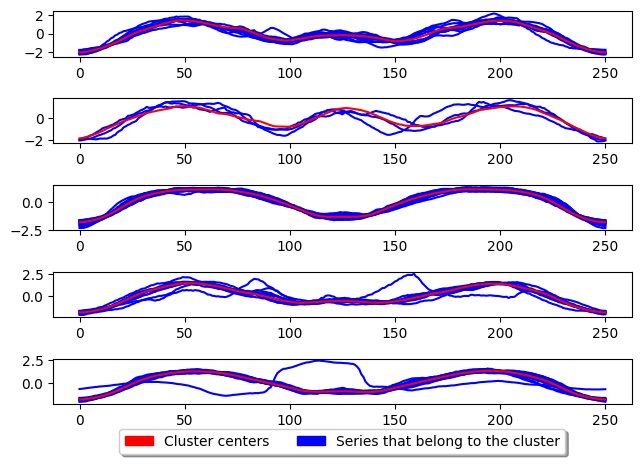
[8]:
# Best configuration for k-means
k_means = TimeSeriesKMeans(
n_clusters=5, # Number of desired centers
init_algorithm="random", # Center initialisation technique
max_iter=10, # Maximum number of iterations for refinement on training set
metric="msm", # Distance metric to use
averaging_method="ba", # Averaging technique to use
random_state=1,
average_params={
"metric": "msm",
},
)
k_means.fit(X_train)
plot_cluster_algorithm(k_means, X_test, k_means.n_clusters)
<Figure size 500x1000 with 0 Axes>
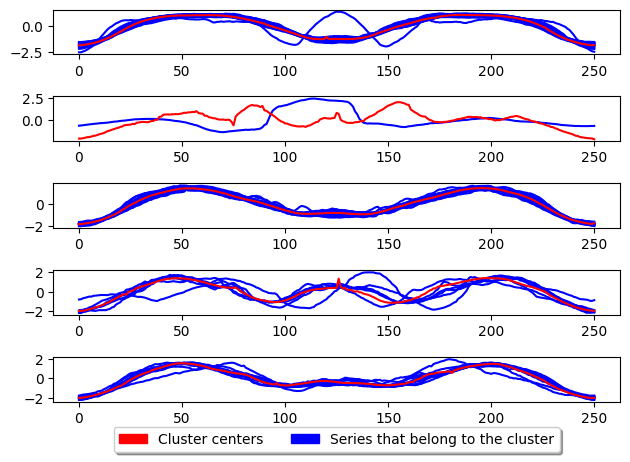
K-medoids
PAM
[5]:
k_medoids = TimeSeriesKMedoids(
n_clusters=5, # Number of desired centers
init_algorithm="random", # Center initialisation technique
max_iter=10, # Maximum number of iterations for refinement on training set
verbose=False, # Verbose
distance="dtw", # Distance metric to use
random_state=1,
)
k_medoids.fit(X_train)
plot_cluster_algorithm(k_medoids, X_test, k_medoids.n_clusters)
<Figure size 500x1000 with 0 Axes>
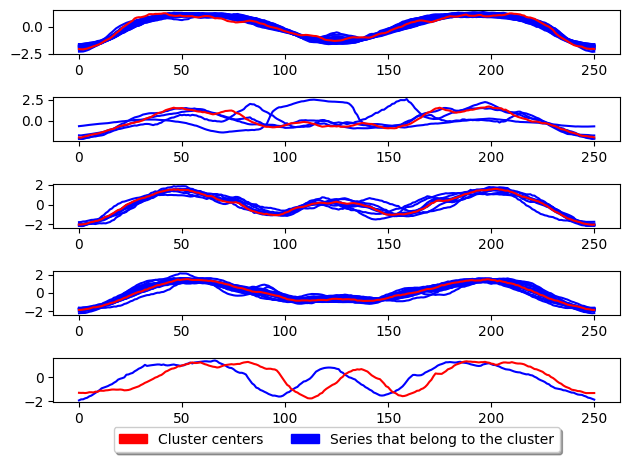
The above shows the basic usage for K-medoids. This algorithm by default uses the partition around medoids (PAM) algorithm to update the centres. The key difference between this and k-means is that the centres are not generated but are instead existing samples in the dataset. This means the centre is an existing series in the dataset and NOT a generated one (the medoid). The parameter key to k-medoids is the distance and is what we can adjust to improve performance for time series. An example of using msm as the metric is given below which has be shown to signicantly improve the performance of k-medoids.
[6]:
k_medoids = TimeSeriesKMedoids(
n_clusters=5, # Number of desired centers
init_algorithm="random", # Center initialisation technique
max_iter=10, # Maximum number of iterations for refinement on training set
distance="msm", # Distance metric to use
random_state=1,
)
k_medoids.fit(X_train)
plot_cluster_algorithm(k_medoids, X_test, k_medoids.n_clusters)
<Figure size 500x1000 with 0 Axes>
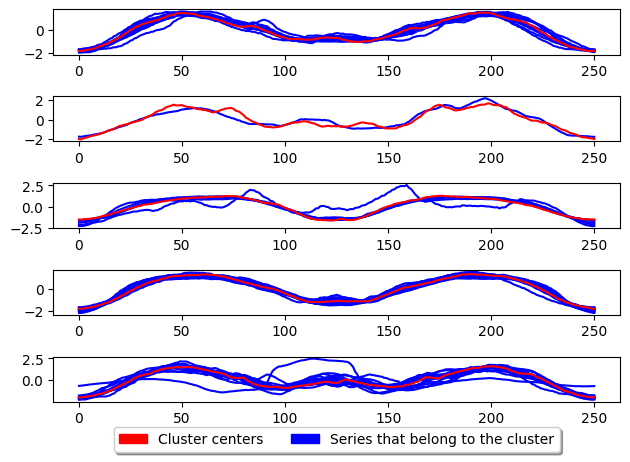
Alternate k-medoids
In addition there is another popular way of performing k-medoids which is using the alternate k-medoids algorithm. This method adapts the Lloyd’s algorithm (used in k-means) but instead of using the mean average to update the centres it uses the medoid. This method is generally faster than PAM however it is less accurate. This method can be used by parsing ‘alternate’ as the parameter to TimeSeriesKMedoids.
[7]:
k_medoids = TimeSeriesKMedoids(
n_clusters=5, # Number of desired centers
init_algorithm="random", # Center initialisation technique
max_iter=10, # Maximum number of iterations for refinement on training set
distance="msm", # Distance metric to use
random_state=1,
method="alternate",
)
k_medoids.fit(X_train)
plot_cluster_algorithm(k_medoids, X_test, k_medoids.n_clusters)
<Figure size 500x1000 with 0 Axes>
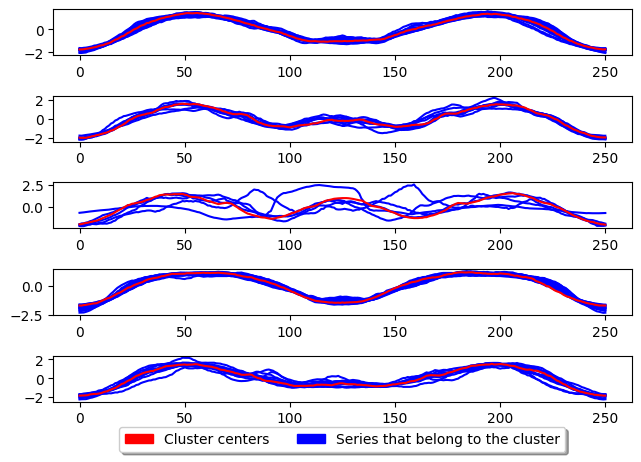
CLARA
Clustering LARge Applications (CLARA) improve the run time performance of PAM by only performing PAM on a subsample of the the dataset to generate the cluster centres. This greatly improves the time taken to train the model however, degrades the quality of the clusters.
[8]:
from aeon.clustering import TimeSeriesCLARA
clara = TimeSeriesCLARA(
n_clusters=5, # Number of desired centers
max_iter=10, # Maximum number of iterations for refinement on training set
distance="msm", # Distance metric to use
random_state=1,
)
clara.fit(X_train)
plot_cluster_algorithm(clara, X_test, clara.n_clusters)
<Figure size 500x1000 with 0 Axes>
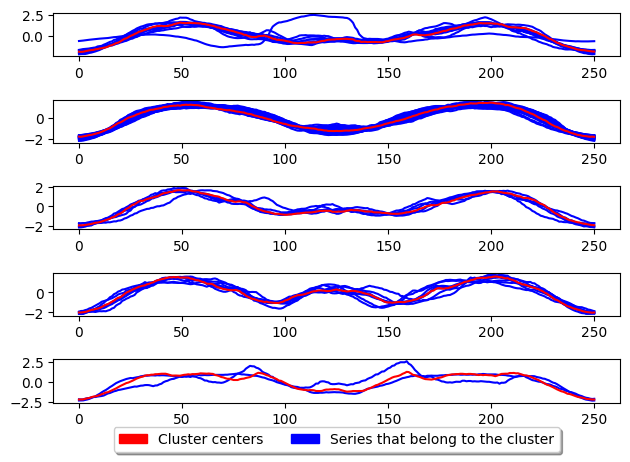
CLARANS
CLARA based raNdomised Search (CLARANS) tries to improve the run time of PAM by adapting the swap operation of PAM to use a more greedy approach. This is done by only performing the first swap which results in a reduction in total deviation before continuing evaluation. It limits the number of attempts known as max neighbours to randomly select and check if total deviation is reduced. This random selection gives CLARANS an advantage when handling large datasets by avoiding local minima.
[3]:
from aeon.clustering import TimeSeriesCLARANS
clara = TimeSeriesCLARANS(
n_clusters=5, # Number of desired centers
distance="msm", # Distance metric to use
random_state=1,
)
clara.fit(X_train)
plot_cluster_algorithm(clara, X_test, clara.n_clusters)
<Figure size 500x1000 with 0 Axes>
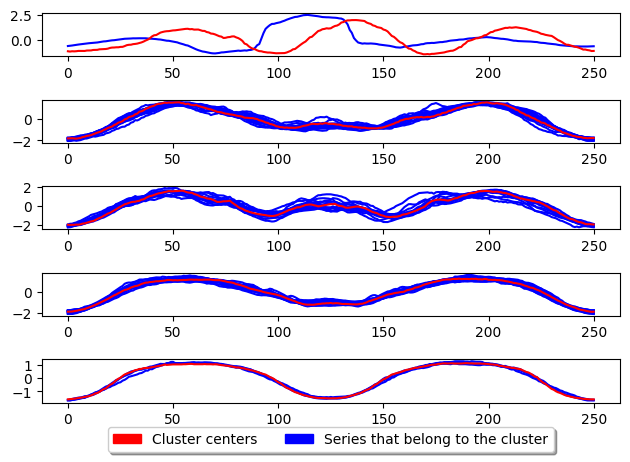
Background info and references for clusterers used here#
One of the most popular TSCL approaches. The goal of the k-means algorithm is to minimise a criterion known as the inertia or within-cluster sum-of-squares (uses the mean of the values in a cluster as the centre). The best distance to use with k-means is MSM [1] and the best averaging technique to use is MBA (to do this see above it is specified how to use barycentre averaging with MSM for k-means) [2].
[1] Christopher Holder, Matthew Middlehurst, and Anthony Bagnall. “A Review and Evaluation of Elastic Distance Functions for Time Series Clustering” Knowledge and Information Systems (2023) [2] Christopher Holder, David Guijo-Rubio, and Anthony Bagnall. “Barycentre averaging for the move-split-merge time series distance measure” 15th International Joint Conference on Knowledge Discovery, Knowledge Engineering and Knowledge Management
TimeSeriesKmedoids is another popular TSCL approach. The goal is to partition n observations into k clusters in which each observation belongs to the cluster with the nearest medoid/centroid. There are two main variants which are PAM and alternate. PAM is the default and is the most accurate but is slower than alternate [3]. The best distance to use with all variants of k-medoids is MSM [1][3].
[3] Christopher Holder, David Guijo-Rubio, and Anthony Bagnall. “Clustering time series with k-medoids based algorithms” 8th Workshop on Advanced Analytics and Learning on Temporal Data (AALTD) at ECML-PKDD 2023
Clustering LARge Applications (CLARA) [4] is a clustering algorithm that samples the dataset, applies PAM to the sample, and then uses the medoids from the sample to seed PAM on the entire dataset. The algorithms main draw is its speed due to the subsample of data used to create the model. For comparison of performance see [3].
[4] Kaufman, Leonard & Rousseeuw, Peter. (1986). Clustering Large Data Sets. 10.1016/B978-0-444-87877-9.50039-X.
CLARA based raNdomised Search (CLARANS) [1] adapts the swap operation of PAM use a more greedy approach. This is done by only performing the first swap results in a reduction in total deviation before continuing evaluation. It the number of attempts known as max neighbours to randomly select and check total deviation is reduced. This random selection gives CLARANS an advantage handling large datasets by avoiding local minima. CLARANS, similar to CLARA, aims to speed up PAM while only slightly degrading the quality of the clusters. For comparison of performance see [3].
[5] R. T. Ng and Jiawei Han, “CLARANS: a method for clustering objects spatial data mining,” in IEEE Transactions on Knowledge and Data Engineering vol. 14, no. 5, pp. 1003-1016, Sept.-Oct. 2002, doi: 10.1109/TKDE.2002.1033770.
[ ]:
Generated using nbsphinx. The Jupyter notebook can be found here.